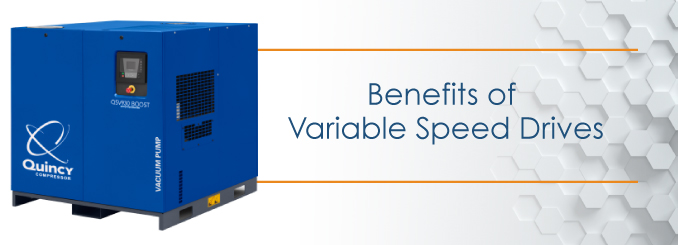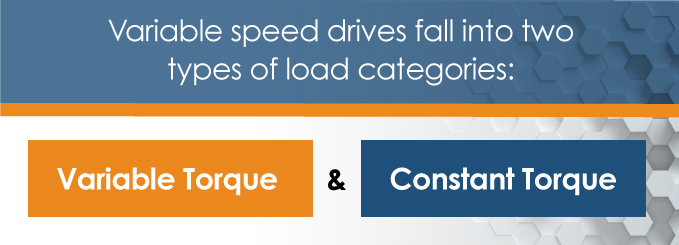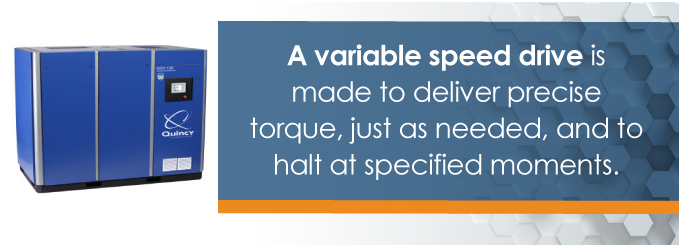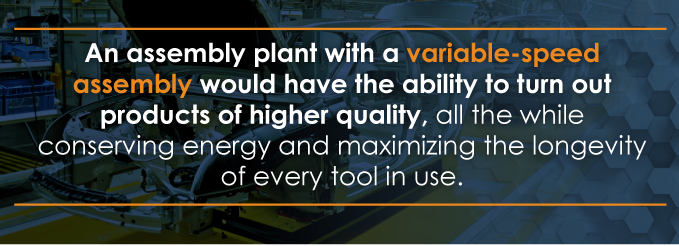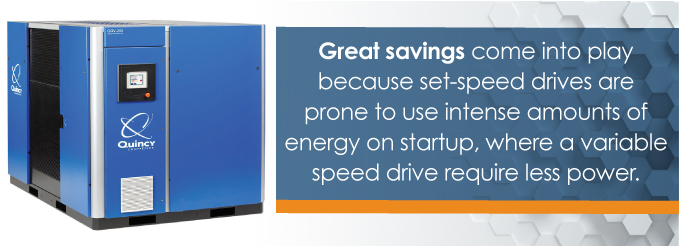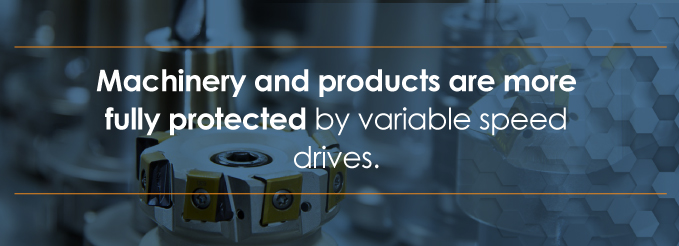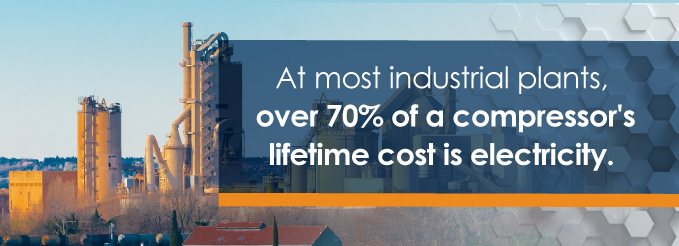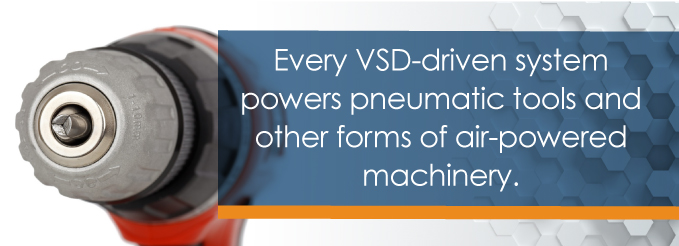Table of Contents
- Variable Torque vs. Constant Torque
- Variable Torque at the Square of the Speed
- Superior Control of Process with Variable Speed Drives
- Variable Speed Applications at Pressing Plants
- Technical Aspects of Variable Frequency Drives
- Unique Benefits of Variable Speed Drives
- World Catches on to Variable Speed Drives
- Is a Variable Speed Drive the Right Choice?
- When Variable Speed Drive Makes Sense
Motors that power multiple applications are generally made to run at uniform speeds, regardless of the application in question. For any machine that runs on an AC motor, you can save money on energy costs with the use of a Variable Speed Drive (VSD), which adjusts the motor’s speed according to the needs of a given application. It converts AC voltage to DC and inverts it back to AC with a variable frequency and voltage.
With a variable speed drive, operations run smoothly and efficiently because processes move according to the demands of a given application. Therefore, you generally won’t find the following problems occurring at facilities where machines are VSD-equipped:
- Slow operations that use too much energy. If the demands of an application are relatively non intensive, the machinery that provides power should adjust the speed, force and torque accordingly.
- Variable applications run at breakneck speeds. On applications that involve a mix of fast and slow motions, the machinery in question must adjust to these needs — otherwise, products incur damage and energy goes to waste.
With variable speed drives, operators of air compressors and other industrial machinery can get precision speeds as necessary, but also enjoy significantly reduced operating costs.
Contact Us Learn More Find a Dealer Near You
Variable Torque vs. Constant Torque
With industrial machinery, there are parts that require constant spinning and others that are best spun on a variable basis. In terms of torque — the force behind rotational speed — variable speed drives fall into two types of load categories:
- Variable torque: Applies to most HVAC applications, such as fans and air pumps.
- Constant torque: Encompasses industrial tools and machinery, such as crushers and conveyors.
In most cases, loads in the first category are more energy efficient than those that employ constant torque. After all, not every application requires maximum or steady spinning speeds. With some machines and pneumatic tools, it’s best for the part in question to rotate at varying speeds throughout each cycle.
Variable Torque at the Square of the Speed
The power used to keep machine parts spinning is similar yet different to the power that applies force. Speed, for instance, might be needed at different levels for applications that involve torque in one section and backward/forward movement in another. In variable torque loads, force requirements correlate with speed as follows:
- Torque = square of the speed
- Horsepower = cube of the speed
When running at half speed, variable torque applications use just one-fourth of the overall energy used at full speed. In a sense, it’s similar to how spinning objects generally move faster and for longer durations than objects made to roll on flat surfaces.
Relatively speaking, HVAC devices generally have low-speed load requirements. As such, operators can save money on energy when using variable speed drives for HVAC applications. In public buildings that rely on large HVAC systems to heat and cool hundreds of rooms up and down dozens of floors, landlords could reap huge savings month after month with VSD-controlled systems. All of this savings could be passed onto tenants and invested in renovations and expansions, which could in turn attract more renters and shoppers.
Superior Control of Processes With Variable Speed Drives
In comparison to other types of AC motor controllers, variable speed drives are the only kind that offer precise speeds at every level of operation. In factories with variable processes, the flexibility and precision of VSD-powered machinery is vital for low-cost, top-quality productions. For instance, if one application requires 840 rpm and another needs 1120 rpm, it would be wasteful and potentially damaging to have a drive that runs everything at 1400 rpm. These are just more of the reasons why variable speed drives are gaining ground on set-speed controllers.
By comparison, competing control methods such as full and soft starters have the following problems:
- Full-voltage starters: Only offer maximum speeds, regardless of whether an application requires fast, medium or slow.
- Soft starters: Whether regular or reduced voltage, these will only rev the motor to full speed and wind it down to a halt.
In contrast, a variable speed drive is made to deliver precise torque, just as needed, and to halt at specified moments. Granted, DC drives are also noted for precision, speed and high-powered torque, but AC motors are more long-lasting, widespread and reasonably priced, which has made AC controllers the preferred standard.
Variable Speed Applications at Pressing Plants
When a motor is run by a single-speed controller, the speed simply catapults from zero to 100 in a split second. Consequently, motors can endure surges that often dangerously exceed load currents. In contrast, variable speed drives work up progressively to appropriate speeds, which spares the motor of undue stress. This, in turn, leads to fewer repairs, less need for maintenance and an overall longer life for the motor and load equipment.
In a factory environment with machines that rely on air compressors, the contrast between single speed and variable speed applications could make a huge difference in terms of the quality of a finished product. Envision the following two scenarios:
- Set-speed assembly: Wood panels are moved along an assembly line for slicing, sanding, spray-finishing and assembling. Each tool and function requires a different speed, pressure or torque, yet the system is run on set controls that fail to recognize these variables.
- Variable-speed assembly: A similar set of processes could be applied, be it for wood or metal construction. Some tools require faster speeds than others, while certain applications call for a varied approach throughout. Thankfully, the system is built to understand these variables.
With little doubt, the second assembly plant would have the ability to turn out products of higher quality, all the while conserving energy and maximizing the longevity of every tool in use.
Technical Aspects of Variable Frequency Drives
Generally, an open-loop VSD will be equipped to calculate its output current and approximate the disparity between speed and setpoint, to which the drive naturally aligns. The bulk of variable torque drives are compatible with proportional-integral-derivative controllers for applications that involve blowers and pressure functions.
Variations in assorted processes — pressure and liquid levels, air and liquid-flow rates — are read by a transmitter, which sends a signal to programmable logic controllers, which in turn act as the process/drive go-betweens. Based on this ongoing feedback, the VSD alters speeds on an as-needed basis.
Out in the field, the majority of drives are paired with Volts/Hertz controls, which work for most applications that run on variable speed drives.
When a motor first becomes energized, the inrush current is roughly 600% of what the regular current would be at full load. Though the current lowers as the motor reaches full speed, the system incurs voltage sag, which can lead to shock damage, motor wear and negative impacts on other loads. A full-voltage starter could also restrict the size-range of acceptable motors for certain load systems.
The Unique Benefits of Variable Speed Drives
In the majority of motor-powered mechanical operations, variable speed drives offer precise, energy-efficient control of force and torque. On any given operation, the foremost benefit of a VSD is twofold:
- Precise electrical control: Motor speeds can be revved up, slowed down, sustained indefinitely or brought to sudden halts.
- Reduced energy costs: With speed levels delivered as-needed rather than at uniform, arbitrary rates, operators can slash energy costs by as much as 70% with variable speed drives.
Additionally, variable speed drives eliminate the need for various secondary mechanical components. Furthermore, a VSD can help you conserve space and reduce the maintenance costs that often accrue over time with motor loads.
Ability to control the starting current. In situations where an AC motor is initiated full-throttle, it requires up to eight times the current just to get the motor and load started. A much lower starting current is needed, however, with a variable speed drive, which ultimately gives the AC motor greater longevity. When you think of all the mechanisms that are powered by this startup current, the more crucial it becomes to ensure machines aren’t initiated with the bluntness that might occur with some of the worst set-speed controllers on the market.
Fewer power line issues. The power system linked to the motor can easily be drained by the following two causes:
- AC-motor initiation across the line
- Starting-current demand
Either problem can cause the power to sag, which could in turn affect other equipment linked to the distribution, including sensors, computers and anything else that’s sensitive to voltage levels. With a variable speed drive, however, you don’t have to worry about sagging power and the damage it can inflict on expensive machinery and electronics.
Reduced power usage on startup. With a variable speed drive, the startup of an AC motor requires less power. This is where some of the greatest savings come into play because set-speed drives are prone to use intense amounts of energy on startup. In many ways, it’s a lot like computer screens and light bulbs, where the more you turn them on and off, the quicker they burn out, which is due to the extra energy that activation requires. Likewise, startup is one of the most energy-intensive things a motor can perform, and the more energy that gets used during these moments, the sooner maintenance is likely to be necessary.
Controlled speed-up process. An AC motor and all connected devices can experience a mechanical shock whenever startup is implemented across the line. Every time a shock like this occurs, each device is subject to a damaging impact. By contrast, variable speed drives slowly begin from nothing and gradually work up to higher speeds, all of which makes for a smoother startup process for full loads.
Modifiable speeds. With a variable speed drive, you can maximize applications and alter processes along the way. Depending on the needs of an application, you can also make the following adjustments:
- Start at slower speeds than normal
- Adjust speed remotely via process controller
For machines that need a bit of warm-up time upon startup, the former option could be the ideal setting. In this respect, some machines and applications are comparable to airplanes in that both need time to launch and soar to full-flight mode.
There are also certain machines that don’t need extra time to activate, but do require some human input due to the variable demands of a given application. Whether it’s an air-powered machine or pneumatic tool, it might need to be programmed remotely or handled manually. For applications like these, it’s best to have a variable-speed drive that can respond to changing needs in speed and torque.
Torque limit adjustability. With accurate control of torque throughout a given process, machinery and products are more fully protected by variable speed drives, which can be programmed to restrict torque and thereby keep the motor from surpassing this threshold. For tools and machines that only need moderate rotational power, the variable drive adjusts accordingly — saving energy in the process by holding back excess power that a set-speed controller would end up using wastefully.
Controlled stopping. Controlled stopping lowers the number of goods that end up ruined because of ruptures and mechanical deterioration caused by shocks and sudden disruptions. This way, there’s less risk of product loss from unexpected impacts that would otherwise be damaging to the mechanisms of a motor. In addition, considering that not all damage inflicted on machinery is caused externally and how damage to internal parts can often be costlier, machines that utilize variable speed drives are far safer with this feature.
Conservation of energy. Variable speed drives cut energy usage significantly in centrifugal load operations such as fans. For example, if a fan runs at only 50% of its normal speed, the horsepower needed to power the device is slashed by a factor of eight. When you factor the rate of energy that goes into a certain process and the amount it accounts for in monthly energy costs, the savings could be exponential, especially when consumption levels are halved.
Ability to operate in reverse. On motors equipped with variable speed drives, there’s no need for reverse starters because outputs can be switched electronically. Not only does this make reverse operations easier and less cumbersome, but it also cuts maintenance expenses and conserves room that might otherwise be consumed by a reversing starter.
Mechanical drive components not necessary. Thanks to the ability of a variable speed drive to adjust speeds as-needed for each application, there’s no need to include a speed-varying device within a mechanical-drive setup. Therefore, you don’t need to use a gearbox or deal with all the attendant issues, such as spacing and additional maintenance. Considering just how costly it can be to repair the complex mechanisms of a gearbox, the ability to cut that component from your arsenal could be one of the biggest benefits of variable speed drives.
Unique movement options. For even greater reductions in mechanical or power stress, a variable speed drive is also capable of controlling the motor in unique patterns. Case in point: The S-curve can be utilized on conveyors for easier speed up/slow down commands, which lessen the possibility of conveyor recoil that sometimes results from abrupt jumps and drops in speed.
The World Catches on to Variable Speed Drives
At most industrial plants, over 70% of a compressor’s lifetime cost is electricity. While a lot of newer facilities have stepped up efforts to slash these kinds of costs, the movement toward conservation has been largely a joint effort between manufacturers and the public that supports them. After all, efficiency relies just as heavily on energy awareness as it does on reductions in wasteful usage. At the center of these developments are technological innovations like variable frequency drives, which have made it possible to be more efficient.
Significant amounts of money can be saved with the installation of air compressors that run on variable speed drives. As such, nations are promoting VSD compressors across the industrial sector in an effort to conserve energy and cut down on waste. In some countries, incentives in the form of loans and tax rebates are being offered by the government for companies to upgrade compressed-air systems.
Case in point: The U.K. relies on compressed air for much of the nation’s energy — trouble is, much of this energy goes to waste. As the adoption of variable-speed air compressors becomes more commonplace throughout the island nation, the British government hopes to reduce emissions and maximize savings among energy providers.
Is a Variable Speed Drive Compressor the Right Choice?
Despite the benefits of variable speed drives, VSD compressors are not ideal for every industrial application. When a variable speed compressor runs nonstop at maximum speed, a factory could consume more energy due to the switch losses of the VSD frequency converter.
Poorly designed and maintained compressed air systems cause significant energy losses and waste. To avoid squandering energy in compressed air production, consider a properly sized VSD compressor.
While many plants require continuous operations seven days a week, lulls in production present energy savings. For example, there are 168 hours in a week. Many compressed air systems only require full capacity between 60 and 100 hours, or about half the time.
When this partial demand load occurs, the air compressor output capacity must be regulated or stopped. With units 15 horsepower or larger, it isn’t feasible to stop and start the air compressor motor several times an hour throughout the day, so operations use a form of inlet control regulation. Whether you run the unit with a load/no-load control (fully loaded or closed inlet for unload and bleed-down) or modulation (cutting back the inlet throttle plate) to accomplish a partial load run-time, these control systems may not be efficient.
A compressed air energy audit of the demand profile, compressed air usage patterns, available air storage capacity and piping network, and operating environment determines if a VSD compressor can provide the desired energy efficiency.
When a Variable Speed Drive Makes Sense
Properly sized VSD compressors let you fine-tune compressor output to fluctuating compressed air demands. By varying the speed of its drive motor, the VSD lowers delivered airflow and electrical power consumption in a largely linear fashion as demand decreases.
VSD compressors minimize energy consumption when fluctuating demand is standard. Due to the comparatively low in-rush currents inherent in variable speed drive motor designs, some VSD compressors will stop at lower compressed air demands vs. idling at unloaded conditions. Even with several starts per hour, idling time is virtually eliminated.
Compressed air system performance analyses show many air compressor applications are ideal for VSD. Compared to a fixed-speed drive compressor, a VSD compressor can yield significant power savings when properly sized for the same end-use.
Compressed air costs can decrease by one-third based on the demand profile. Due to economic cycles and manufacturing shifting to other countries, many facilities have significantly reduced the volume of compressed air needed and are operating oversized air compressors. Facilities should review their compressed air needs when significant production and compressed air demand profiles change. Additionally, many local municipalities and state utilities offer rebate incentives for energy-saving compressed air solutions like VSD.
Facility managers must continually find new ways to cut energy costs. Many corporations have instituted policies with aggressive annual energy reduction targets.
The Potential Cost Savings of VSD Compressors
Let’s say a manufacturer’s compressor system is running a 200-horsepower air compressor. The operation has fluctuating compressed air demands 24 hours a day at 3 cents per kWh. These energy costs have doubled in five years, increasing in some areas to 8 cents per kWh or more.
The annual cost to operate that compressor at 3 cents per kWh was $41,273. Today, that same compressor costs $110,062 yearly, or more than half a million dollars over five years.
A detailed compressed air demand assessment determines the fluctuations were within the control range and averaged 35% less than the compressor’s full capacity. Let’s also say the factory had inadequate storage. Switching to a properly sized VSD compressor could potentially save this facility $38,521 annually, or more than $192,000 in five years if the current conditions remain.
Combine these savings with the greater efficiency of replacing old equipment, and the ROI is often met in fewer than two years. Not every installation can yield this ROI, as that’s the purpose of a professional air demand assessment and proper compressor selection, but it’s worth considering. Audits are performed by compressed-air industry specialists who can determine whether VSD is the best means of system control.
By varying output to meet compressed air demands, manufacturers who add a properly sized VSD compressor can realize immediate energy savings that compound over time.
Quincy: The Leading Maker of Variable-Speed Drive Air Compressors
All across the world, there’s a growing movement among engineers and industrial operators to replace set-speed controllers with variable speed drives. In the industries that have already made this move, the up-sides have been substantial in terms of energy savings, machine life and product quality. Nonetheless, with every VSD-driven system that powers pneumatic tools and other forms of air-powered machinery, the success of each application relies foremost on high-quality air compressors.
Since the Roaring Twenties, the leading name in compressed-air machinery and innovation has been Quincy Compressor, makers of the finest air compressors and pneumatic tools for operations of all sizes. At domestic and foreign automotive assembly plants, Quincy compressors have powered the tools that turn car parts into beautiful, prestigious, highway-bound hot rods, compacts and vans. In factories that produce canned goods and furnishings, our machinery has given compressed-air power to assemblies that put food onto grocery aisles and make beds and sofas ready for home delivery.
Since the dawn of the 21st century, a new awareness has taken hold of the industrial sector. Gone are the days when manufacturers were happy just to maximize profits with the lowest possible overhead — today, all companies that thrive make eco-friendliness a central tenet of brand identity. As part of that goal, innovations in compressed-air technology have made the variable speed-driven air compressor into an industry standard among companies around the world. With one innovation after another, Quincy has led the way in making variable-speed driven air compressors more commonplace in all industries that rely on air power.
For a wide range of applications, the finest compressed-air systems are those that run on variable speed drives. Not only do VSD-driven units offer some of the greatest longevity and energy efficiency, but they also adjust to the variable speed and torque requirements of each application. For commercial, private and public uses alike, Quincy makes air compressors that are equipped with the latest variable-speed controllers. To find out more about our vast inventory of air compressors and related products, visit our sales and services page.


